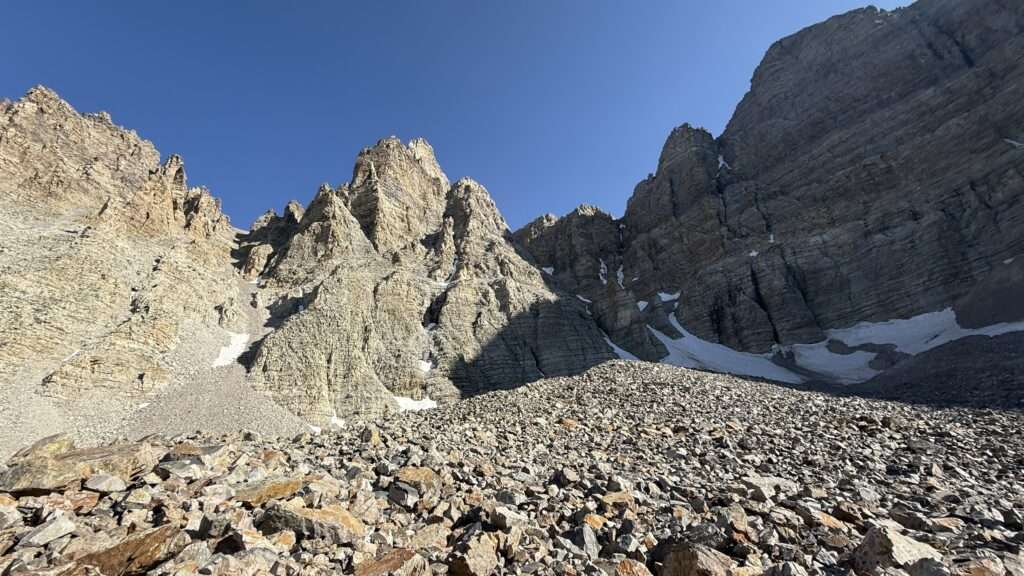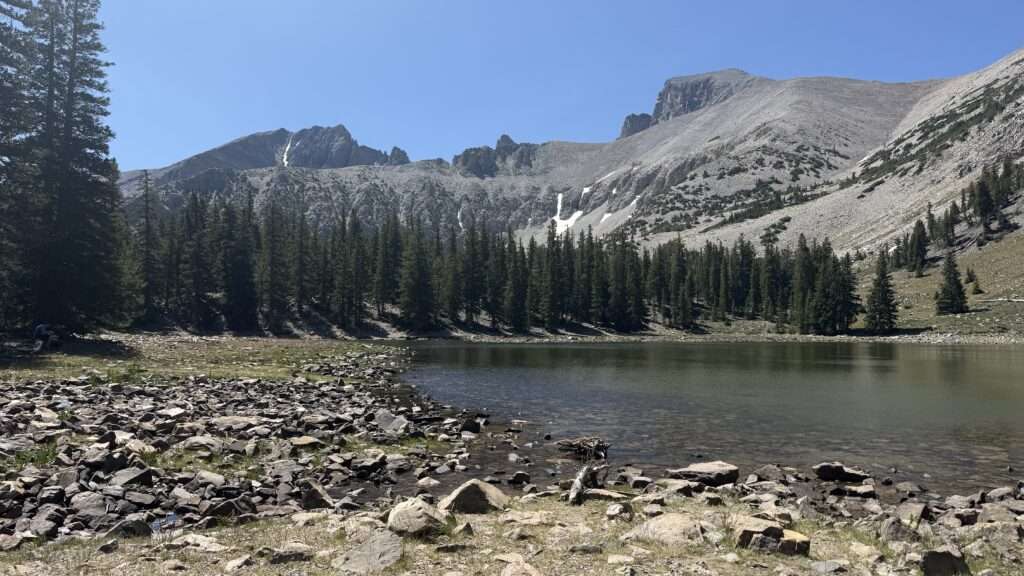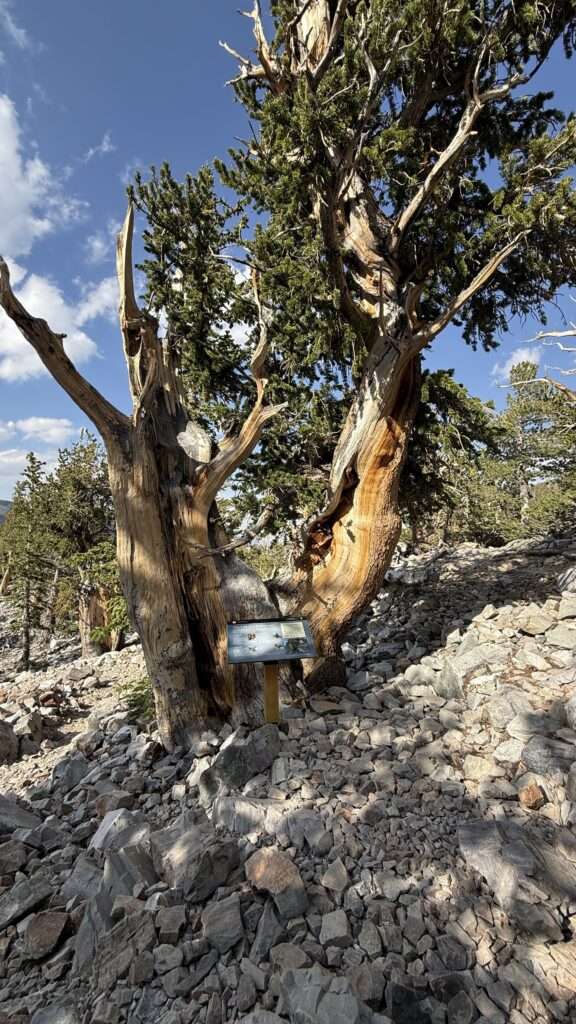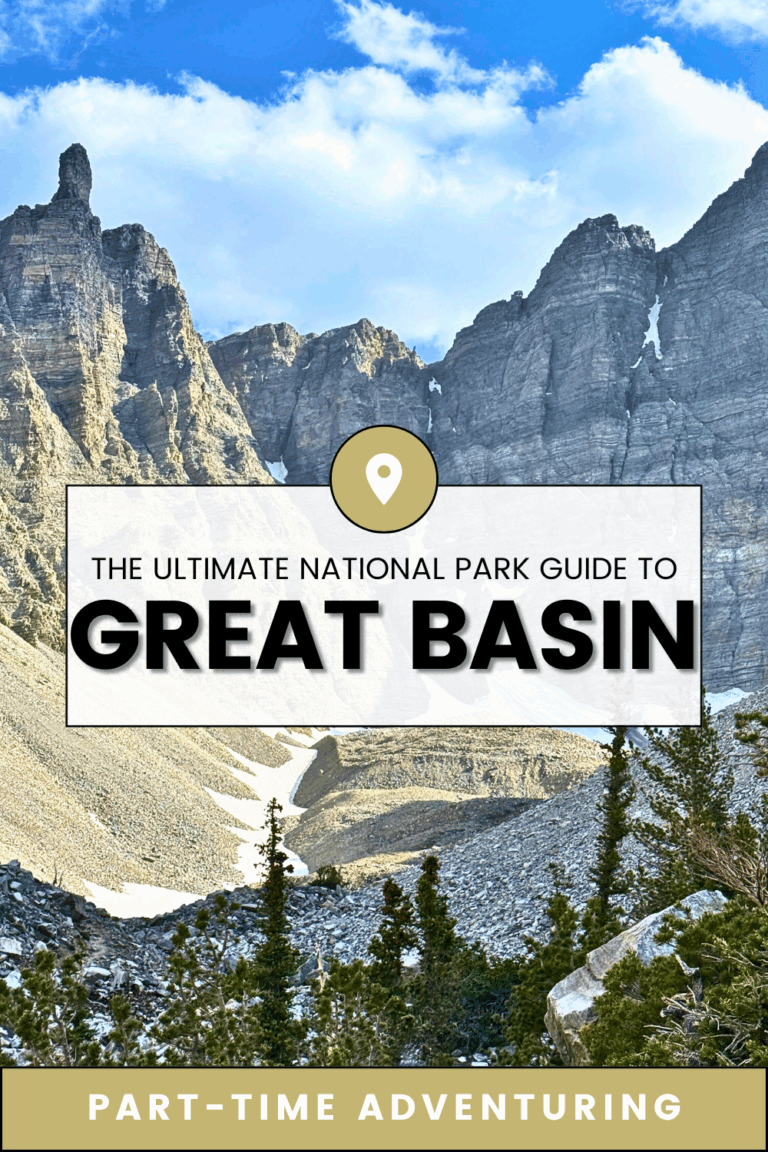Great Basin National Park is one of the most underrated national parks in the United States. Tucked away in eastern Nevada near the Utah border, this park offers an incredible range of experiences: ancient bristlecone pine forests, glacier-carved alpine lakes, a towering 13,000-foot summit, marble caves, and some of the darkest night skies in the country. If you’re planning your first trip, this in-depth guide covers everything you need to know—including camping, cave tours, essential hikes, and practical planning tips.
First Timer’s Guide to Great Basin National Park
Where Is Great Basin National Park Located?
Great Basin National Park is located in eastern Nevada, near the town of Baker. The park is remote, which is part of its charm. Baker is a tiny town with minimal services, so plan to come prepared.
Driving distances:
- From Salt Lake City, UT: ~4 hours (234 miles)
- From Las Vegas, NV: ~5 hours (295 miles)
- From Ely, NV: ~1.5 hours (67 miles)
- From Zion National Park: ~4.5 hours
The nearest airport is in Cedar City, Utah, but most travelers drive in from major hubs.
When Is the Best Time to Visit Great Basin?
The park is open year-round, but the most popular time to visit is between late May and mid-October.
- Summer (June–September): Best time for high alpine hiking, cave tours, and camping. Wildflowers peak in July.
- Fall (late September–October): Quieter, with stunning fall foliage from the aspens. Cooler temps, fewer bugs.
- Winter: Scenic but limited access. Wheeler Peak Scenic Drive closes after snow accumulates.
Note: Always check current conditions on the NPS website before your trip.
What to Expect: Elevation, Climate, and Crowds
- Elevation ranges from 6,800 ft in the valley to 13,063 ft at Wheeler Peak.
- Weather is highly variable: July highs average 80°F at the Visitor Center but can dip below freezing at Wheeler Peak Campground at night.
- Crowds: With fewer than 150,000 annual visitors, it’s one of the least visited national parks—ideal for solitude seekers.
Camping at Great Basin National Park
There are a few reservable campgrounds within the boundaries of Great Basin National Park.
Why Wheeler Peak Campground Is the Best

Wheeler Peak Campground sits at 9,886 feet and offers the most convenient access to many of the park’s best hikes.
- 37 sites, non-electric, tent and RV accessible (not ideal for large rigs)
- Shaded sites in pine forest, many with mountain views
- Easy access to the Alpine Lakes Loop, Bristlecone Pine Trail, and Wheeler Peak Summit Trail
- Vault toilets, potable water, picnic tables, bear boxes
- Higher elevation means cooler temps.
Reservations: Available on Recreation.gov, book early during peak season.
Overview of Other Campgrounds
- Lower Lehman Creek Campground: Closest to Lehman Caves and Visitor Center; open year-round; reservable.
- Upper Lehman Creek Campground: Mid-elevation; shaded sites with creek access.
- Baker Creek Campground: More remote; gravel road access; peaceful and quieter.
Camping Tips
- Nights are cold year-round; bring a 20°F or lower-rated sleeping bag.
- Campfires may be restricted—check alerts.
- There are no showers in the park.
What to Pack for Great Basin National Park
Clothing & Gear Essentials
- Layers: Synthetic or wool base layers, fleece jacket, insulated puffy, waterproof shell
- Footwear: Sturdy hiking boots with ankle support
- Accessories: Warm beanie, gloves, sunhat, sunglasses, buff
- Other: Headlamp, trekking poles, hiking daypack (20L+), hydration bladder or 2-3L bottles, trail map or GPS
Specialty Items
- Star-gazing gear: Binoculars, red headlamp, stargazing blanket
- Cooking gear: Camp stove, utensils, bear-proof food storage (bears are rare but use boxes where provided)
- Food: All groceries and ice should be purchased before arriving—Baker has extremely limited options
Great Basin : How to Acclimate to High Elevation
Spending time at Great Basin means spending time well above sea level, with most major attractions located above 7,000 feet. High elevation can affect even seasoned hikers if you aren’t used to it, so it’s important to plan your days accordingly to avoid symptoms of altitude sickness.

Tips for Adjusting to Elevation
- Stay Hydrated: Aim for at least 3-4 liters of water a day. Dry air and high altitude mean you lose moisture faster.
- Avoid Alcohol: It can contribute to dehydration. It’s best to skip this during your first 24 hours in the park.
- Recognize Symptoms: Headache, dizziness, nausea, and fatigue are signs of acute mountain sickness. If symptoms worsen, descend to a lower elevation.
- Eat Well: Salty snacks help retain fluids, and complex carbs give you energy at altitude.
Sample Acclimation Schedule
Day 1: Arrive in the afternoon and check into your campground. Visit the Great Basin Visitor Center and tour Lehman Caves. The cave tour is at a lower elevation and lets your body begin adjusting gradually.
Day 2: Now that you’ve had a night to acclimate, tackle moderate elevation hikes like the Alpine Lakes Loop and Bristlecone Pine Trail. These trails are scenic and offer great exposure to alpine terrain without overexertion.
Day 3: If you’re feeling strong, try the Wheeler Peak Summit hike. This strenuous route climbs to 13,063 feet and should only be attempted after at least one full day of elevation exposure.
Touring Lehman Caves: What to Know
Lehman Caves is one of the crown jewels of Great Basin. Unlike many limestone caves, Lehman Caves is carved out of marble and contains over 300 rare shield formations—uncommon even among the most decorated caves in the U.S.
Why Visit
- The formations are spectacular: soda straws, stalactites, draperies, and helictites abound.
- The cave is steeped in history, discovered in 1885 by Absalom Lehman.
- It’s a great low-impact activity for Day 1 while acclimating to the park’s elevation.
Booking Your Tour
All tours are ranger-led and must be booked in advance through Recreation.gov.
Tour Options:
- Lodge Room Tour (60 minutes): Easier, shorter tour with plenty of formations.
- Grand Palace Tour (90 minutes): Longer, more immersive tour with access to the most ornate chambers.
Tours often sell out 2+ weeks in advance during peak season, so book early.
What to Bring
- A warm jacket: the cave stays around 50°F year-round.
- Leave backpacks, food, and drinks behind—they are not allowed.
- Photography is allowed, but flash and tripods are not.
Best Hikes in Great Basin National Park
Wheeler Peak Summit Trail
- Distance: 8.6 miles round trip
- Elevation Gain: 3,000+ ft
- Trailhead: Wheeler Peak Campground (approx. 10,160 ft)
- Why It’s Special: One of the tallest peaks in Nevada with panoramic views from the top. The trail traverses alpine meadows and exposed talus fields.
- Best Time to Start: Just before sunrise. Afternoon storms are common at altitude.
- Difficulty: Strenuous. Only attempt if acclimated and weather is favorable.
Alpine Lakes Loop
- Distance: 2.7-mile loop
- Highlights: Passes by two gorgeous alpine lakes: Teresa Lake and Stella Lake. Also includes pine forests, meadows, and possible wildlife sightings.
- Difficulty: Moderate and family-friendly
- Bonus: Can be easily combined with Bristlecone Pine Trail for an extended hike.
Bristlecone Pine & Rock Glacier Trail

- Distance: 2.8 miles to Bristlecones, 4.6 miles round trip to include the glacier
- Why Go: Walk among trees that are more than 3,000 years old. Interpretive signage adds context about climate, geology, and ecology. Continue to the rock glacier for a dramatic view of the glacial remains beneath Wheeler Peak.
Stargazing in Great Basin National Park
Why It’s Special
Great Basin is one of the best places in the continental U.S. for stargazing. It is a designated International Dark Sky Park with minimal light pollution. The Milky Way is often visible with the naked eye.
Best Stargazing Locations
- Wheeler Peak Campground: High elevation + open skies
- Mather Overlook: Pull-off on the Scenic Drive
- Baker Archaeological Site: Flat, open terrain outside town
Night Programs
- Hosted seasonally by the National Park Service at the Lehman Caves Visitor Center
- Include ranger talks and telescope viewing
- Bring a red light (or red filter for your flashlight) to protect night vision
- New moon nights offer the darkest skies—check a moon phase calendar before your visit
Sample 2- or 3-Day Itinerary for First-Time Visitors
Day 1: Arrival + Acclimation
- Set up camp at Wheeler Peak Campground
- Stop at the Visitor Center to get maps and check on trail conditions
- Tour Lehman Caves (reservations required)
- Take a short scenic drive up Wheeler Peak Scenic Road
Day 2: Alpine Exploration
- Hike the Alpine Lakes Loop in the morning
- Continue to Bristlecone Pine Trail and Rock Glacier if acclimated
- Picnic lunch at the Wheeler Peak day-use area
- Stargazing at Mather Overlook after sunset
Day 3: Summit or Solitude
- Start Wheeler Peak Summit Trail early if you’re well acclimated and weather permits
- Alternate: Hike Baker Lake or Johnson Lake for quieter backcountry trails
- Break down camp and head home with plenty of time for scenic stops
Final Thoughts on Visiting Great Basin National Park
Great Basin is a park that invites you to slow down. It’s not about checking off bucket-list sights or fighting crowds—it’s about soaking up alpine stillness, stargazing under one of the darkest skies in the U.S., and standing among some of the oldest living trees on Earth.
Before you go, remember to prepare:
- Download offline maps—cell service is virtually nonexistent in the park, even near popular campgrounds.
- Stock up on essentials—there are no services inside the park. The nearby town of Baker offers only very limited fuel, food, and supplies.
- Practice Leave No Trace—stay on marked trails, pack out all trash, and respect wildlife so this quiet, wild place stays pristine for future visitors.
Whether you’re camping beneath Wheeler Peak, wandering among bristlecones, or simply stargazing in silence, Great Basin rewards those who take the time to linger. For first-time visitors, it might just become one of your favorite underrated national parks.

